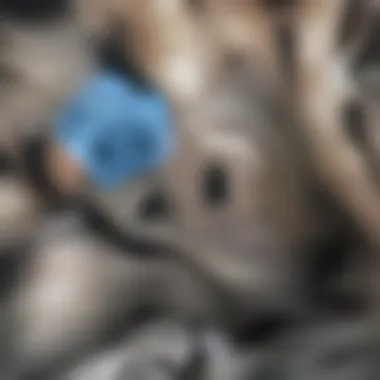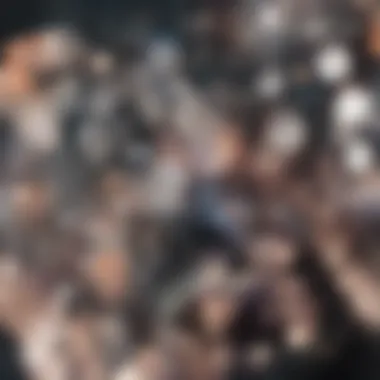The Evolution and Impact of Internet Memes


Intro
In the digital age, internet memes have emerged as a vital form of communication. These visual snippets often encapsulate complex ideas, humor, and social commentary in a digestible format. As we navigate the vast expanse of online culture, understanding the evolution and impact of these memes becomes increasingly essential. They have impacted how people connect, express their thoughts, and even engage in political discourse.
The allure of memes lies in their ability to transcend language barriers and convey meaning rapidly. As they proliferate across various platforms, such as Reddit and Facebook, their role in shaping conversations and cultures cannot be underestimated.
As this article unfolds, we delve deeper into their origins, evolution, and societal implications, aiming to provide readers with a comprehensive understanding of what memes represent in today's world.
Key Concepts
Definition of Primary Terms
Memes are often defined as units of culture that propagate from person to person via imitation. This concept, coined by Richard Dawkins in his 1976 book "The Selfish Gene", emphasizes the replicative nature of cultural elements. In the context of the internet, memes typically consist of images, videos, and text snippets that can be easily shared and modified.
Related Concepts and Theories
Several theories provide insight into the dynamics of memes. For instance, the theory of viral marketing applies to the way memes spread. Just as businesses aim to create content that goes viral, meme creators often utilize similar strategies. Understanding these dynamics takes us beyond mere entertainment, revealing how memes serve as tools for shaping public opinion and mobilizing communities.
Furthermore, the evolution of memes can be seen as a reflection of societal changes and collective attitudes. This can be observed in the transition from simple images emphasizing humor to more nuanced memes that address serious topics, including political issues and social justice.
"Memes act as a mirror to society, reflecting not just humor but also the zeitgeist of the times."
Future Directions
Gaps Identified in Current Research
Despite their growing significance, research on internet memes remains limited. Many studies focus on isolated elements rather than the broader context in which memes operate. There is a need for interdisciplinary approaches that encompass sociology, psychology, and communication studies to fully grasp their impact.
Suggestions for Further Studies
Future research could explore the long-term effects of meme culture on identity formation and group dynamics. Also, examining how memes can influence and shift narratives in political and social contexts offers fertile ground for investigation.
By addressing these gaps, scholars might uncover critical insights into the role of memes as catalysts for social change and commentary in contemporary society.
Prelude to Internet Memes
Understanding internet memes is crucial in examining contemporary digital culture. Memes not only shape the communicative landscape but also reflect and influence societal norms and values. As a ubiquitous form of expression, they evoke reactions and create dialogues among diverse audiences.
The significance of internet memes lies in their capacity to convey complex ideas succinctly and humorously. They often encapsulate a shared experience or commentary, allowing for engagement across different demographics. In the fast-paced environment of social media, memes serve as a means of rapid communication, transcending language barriers in many cases.
Memes are more than simple images or videos; they can act as catalysts for social movements, reflecting collective sentiments and forging connections among users. This article explores the multifaceted nature of memes, delving into their definitions and historical context to provide context for their evolution and impact.
Defining Internet Memes
Internet memes are units of cultural information that spread virally through various online platforms. They often take the form of images, videos, or phrases, modified and shared by users to add humor, irony, or critique. The essence of a meme is its relatability; they resonate with audiences and evoke shared understanding.
Characteristics of memes may include:
- Simplicity: Easily consumable content, often with minimal text.
- Reproducibility: Users can create and adapt memes, fostering a collaborative nature.
- Humor: Many memes employ humor as a way to engage users and prompt sharing.
The ease with which memes can circulate contributes to their role in shaping digital conversations.
The Historical Context of Memes
The concept of memes predates the internet, originating from Richard Dawkins' 1976 book, The Selfish Gene, where he introduced the term "meme" to describe how cultural ideas propagate. However, the actual application of memes in the digital sense began in the late 1990s with early internet forums, where users shared images and phrases in a contextual manner.
Notable early examples include the Dancing Baby and Hampster Dance. As social media platforms such as MySpace and Facebook emerged, the potential for viral sharing increased, leading to the rapid evolution of internet memes. Websites like Reddit and 4chan played a pivotal role in this development, providing spaces for users to create and share memes widely.


The rise of social media has thus transformed memes from isolated occurrences to global phenomena, making it imperative to understand their role in today's information landscape.
The Mechanics of Meme Creation
The mechanics of meme creation are vital to understand the lifecycle and impact of memes on digital culture. Without grasping the essential components, platforms, and tools involved in the creation and distribution of memes, one cannot fully appreciate their far-reaching influence. This section delves into various aspects that drive meme culture, highlighting how memes evolve, spread, and resonate within society.
Components of a Meme
Memes consist of several key components that contribute to their effectiveness and appeal. At the core, memes usually include an image or video paired with humorous or thought-provoking text. This combination can elucidate a social context or a cultural critique.
- Visual Element: The visual component grabs attention and often elicits an immediate reaction. Images such as celebrities, animals, or classic paintings often serve as familiar references to the audience.
- Textual Commentary: Text is critical in conveying the intended message. It can be a clever caption, a punchline, or a statement that enhances the visual context.
- Cultural Reference: Relating to shared experiences or current events makes a meme more relatable and impactful. These references may draw from popular culture, politics, or social situations.
As a whole, these components work together to create not just humor but also a means of communication and commentary.
Platforms for Meme Sharing
The internet is replete with various platforms that facilitate the rapid sharing and proliferation of memes. Each platform serves different demographics and has unique characteristics that influence meme culture:
- Reddit: Known for its community-based approach, Reddit allows users to create niche subreddits where specific memes can gain traction within smaller groups. The upvote system further promotes popular memes.
- Facebook: This platform enables wide-reaching shares among friends and family, creating opportunities for viral content. Memes related to trending events often see vast engagement.
- Instagram: This visually-driven platform forms an ideal space for image-based memes. The use of hashtags enhances discoverability, allowing memes to reach broader audiences.
- Twitter: Known for brevity, Twitter allows quick sharing of ideas and memes. It acts as a fast-paced environment where memes can rapidly accelerate in virality.
Understanding these platforms is crucial, as they dictate how memes are consumed and shared in different contexts.
Tools and Software for Meme Generation
Creating memes has become accessible thanks to a variety of tools and software. These applications streamline the process, enabling even those with little technical background to partake in meme creation:
- Canva: This graphic design tool provides templates specifically for memes, simplifying the addition of text to images.
- Imgflip: A dedicated meme generator that allows users to select popular meme templates and customize them with original text.
- Photoshop: For more advanced users, Adobe Photoshop offers robust editing capabilities for creating more intricate memes.
The availability of these tools lowers the barriers to entry, allowing a greater range of users to express themselves creatively. As a result, the landscape of memes becomes more diverse and reflective of different voices.
Categorization of Internet Memes
The categorization of internet memes is vital for understanding their diverse forms and functions within digital culture. Recognizing different types of memes helps researchers, educators, and enthusiasts grasp how they communicate ideas and sentiments in contemporary society. This section outlines the major categories of memes, emphasizing the significance of their classification in studies of digital expression and social commentary. Each category reflects varying techniques, themes, and cultural contexts that shape the audience's reception and interpretation.
Image Macros and Their Variants
Image macros serve as one of the most recognizable forms of internet memes. These typically consist of an image paired with a caption, conveying humor, irony, or social commentary. A staple of platforms like Reddit and Facebook, image macros often employ familiar visual templates that users readily recognize.
Variants of image macros can include alterations in the image, wording, or format to better fit the creator's intention or current events. For example, the "Distracted Boyfriend" meme illustrates personal conflict in relatable scenarios. This adaptability illustrates how meme culture evolves in reaction to societal changes, thus enhancing their relevance and resonance.
Video Memes and Trends
Video memes are an increasingly popular category, capitalizing on platforms like TikTok and YouTube. They encompass a variety of formats, including short clips, remixes, and parody videos. Trends often emerge from viral challenges or popular sound bites, encouraging users to create their unique interpretations by combining visuals and audio.
Videos can convey complex messages in mere seconds, allowing for faster dissemination of ideas and humor. They can tap into emotions more effectively than static images, thus creating a more profound impact on audiences. Video memes often become vehicles for activism and social commentary, reflecting zeitgeist in real-time.
Viral Challenges and Their Impact
Viral challenges are another significant aspect of meme culture. These challenges typically involve users engaging in specific activities or tasks, often driven by a particular theme or goal. Examples include the "Ice Bucket Challenge" and the "Mannequin Challenge."
Engagement in these challenges fosters a sense of community among participants. While some may argue that they promote superficial engagement, these challenges can also raise awareness for serious issues, encourage creativity, and even lead to fundraising efforts. They are a testament to the power of collective action online and their ability to impact society positively.
Text-based Memes and Format Variations
Text-based memes are less visual but equally important compared to their image or video counterparts. These often manifest as quotes, status updates, or humorous sayings that resonate with specific audiences. The simplicity of text memes allows for broad interpretation and adaptability. They can be easily shared across various platforms, connecting users through shared sentiments or experiences.
Format variations include the use of hashtags, paragraphs, or dialogue. These approaches serve to enhance user engagement and foster dialogue around the topic, showcasing the dynamic nature of how memes can evolve through language.
In summary, understanding the categorization of internet memes provides insight into their structural components and sociocultural implications. Each type—be it image macros, video memes, viral challenges, or text-based formats—offers a unique lens through which audiences can explore ideas and commentary on pressing societal issues. Recognizing these distinctions allows for deeper engagement with memes as both an art form and a source of social discourse.


Sociocultural Implications of Memes
Memes play a significant role in modern digital life, impacting various aspects of society. They are not just humorous images or videos; they are also reflections of cultural narratives and collective sentiments. By examining the sociocultural implications of memes, we can understand how they function as a means of communication, influence humor, and participate in political discourse.
Memes as a Form of Communication
Memes serve as a distinct form of communication in today's internet landscape. They allow users to convey complex ideas, reactions, or emotions succinctly. Through visual and textual formats, memes can encapsulate diverse concepts, making them easily shareable and relatable. This ability to communicate effectively in compact forms contributes to the way information spreads on social media platforms.
For instance, a meme about a common experience can resonate with many individuals, fostering a sense of community. The rapid sharing of memes creates a shared language among internet users, transcending cultural and geographical barriers. In a world characterized by information overload, memes simplify and clarify messages while providing entertainment.
The Role of Humor in Memes
Humor is a crucial element in many memes. It allows people to engage with serious topics in a light-hearted manner. This can help with coping mechanisms, as humor often serves as a form of release in stressful times. Through memes, individuals can address societal issues or personal dilemmas while promoting laughter and connection.
Different types of humor, including irony, satire, and sarcasm, are prevalent in meme culture. By employing humor, memes challenge social norms and critique behaviors, sparking conversations about various issues. Moreover, the accessibility of memes allows people to participate in dialogue without necessitating deep expertise on the subject, making discussions easier to initiate and share.
Memes and Political Discourse
Memes have become significant players in political discourse, providing a platform for expression and mobilization. They can simplify complex political content into relatable images or phrases, making them more digestible to the average person. This has implications for political engagement, as memes can drive discussions about policies, political figures, and social movements.
Political memes can mobilize support or opposition, acting as forms of digital activism. Memes circulated during election periods often influence public opinion or highlight particular issues within society. By harnessing both humor and relatability, these memes can reach and resonate with broader audiences, contributing to their effectiveness.
"Memes have transcended traditional boundaries of communication, becoming a unique hybrid of expression that reflects the zeitgeist of our digital age."
The Lifecycle of a Meme
The lifecycle of a meme is a critical framework for understanding its journey from creation to potential decline. Each phase offers significant insights into how memes influence and are influenced by digital culture. This section will discuss how memes are created, how they gain traction and acceptance, and how they eventually fade or transform, leaving a lasting impact on social communication and media.
Creation and Initial Spread
The process of meme creation begins with an idea or concept that resonates with individuals. Memes often emerge from relatable situations, trending topics, or shared sentiments. Creative individuals utilize various tools and platforms, such as Imgflip or Meme Generator, to craft these initial iterations. The simplicity of meme creation empowers anyone with internet access to participate, democratizing the art form.
Initial spread occurs primarily through social media channels. Platforms like Reddit and Facebook serve as breeding grounds for memes, allowing for rapid sharing and engagement. In this phase, a meme often circulates within niche communities before breaking into larger audiences. Viral potential hinges on factors like humor, relatability, and the timing of the post. Memes that capture highly relatable emotions or commentary often spread quicker and further than others.
Mainstream Acceptance and Evolution
Once a meme gains traction, it can achieve mainstream acceptance. This phase is marked by widespread recognition, where the meme transcends its original context and is adopted by different demographics. Classic examples include the "Distracted Boyfriend" and "Woman Yelling at a Cat," which have been repurposed by countless users for various applications.
During this time, memes also evolve. Variations sprout as individuals add their unique spin to them. This evolution can lead to sub-memes, where specific formats appeal more to certain groups or clusters. The adaptability of a meme contributes to its longevity, which can transform a simple image or phrase into a cultural phenomenon. Brands often take notice during this phase, leveraging popular memes for marketing strategies, thus intertwining commercial interests with meme culture.
Decline and Legacy
Despite their initial surge in popularity, memes eventually reach a point of decline. This can be due to oversaturation; when a meme is recycled excessively, it loses its novelty and relevance. The initial charm fades, leaving many users disenchanted with its repetition. Other factors may influence this decline, such as shifts in cultural context or new meme formats emerging.
However, just because a meme declines doesn't mean it disappears altogether. Many memes leave a lasting legacy, influencing future content and even language. Past memes can re-emerge or be referenced in various contexts. Furthermore, their evolution often guides the creation of new memes.
"Memes often articulate complex social ideas, and their lifecycle reflects changing dynamics within digital culture."
In summary, understanding the lifecycle of a meme provides critical insight into how ideas are shared, accepted, and ultimately transformed within digital spaces. It highlights the interplay of creativity and social dynamics, contributing to the broader implications of meme culture on society.
Memes in the Age of Information
Memes have emerged as a powerful tool and reflection of contemporary digital culture. They are more than just humorous images; memes encapsulate complex ideas, emotions, and social dynamics in a digestible format. In today's information-saturated environment, their role becomes even more significant. The speed at which memes travel through the internet, often capturing fleeting social attitudes, has transformed how media is consumed and shared.
Impact on Traditional Media
Traditional media is facing an ongoing transformation, significantly influenced by the rise of memes. Whereas news outlets used to control the flow of information, memes have democratized content creation. They provide a voice to the masses, enabling individuals to comment on current events and cultural phenomena with immediacy and creativity. Memes often go viral quicker than traditional news articles, sometimes prompting media outlets to report on them rather than the original source itself.
- Speed of Information: Breaking news today can be conveyed through a meme, often before formal articles are written. This immediacy can shape public perception faster than traditional reporting.
- Audience Engagement: Memes encourage user interaction, as individuals share their interpretations. This shifts engagement from passive consumption to active participation.


In essence, memes have altered the landscape of information dissemination, driving home the importance of viewing them as part of the media dialogue rather than mere entertainment.
Memes as Tools for Activism
Memes have gained traction not just for humor or entertainment, but as significant instruments for activism. Their ability to condense complex social issues into relatable visuals and text makes them effective for raising awareness. Each meme posted on social media can bring critical issues to larger audiences and spark conversations about pressing matters.
- Accessibility: Memes are easy to create and share, making them excellent tools for grassroots movements and organizations.
- Diverse Messaging: From climate change to social justice, memes can shift focus towards underrepresented issues and mobilize individuals to take action.
- Viral Potential: Well-crafted memes can spread quickly, reaching potentially millions within hours.
These elements illustrate how memes can amplify voices within movements, affecting tangible change and promoting discourse.
The Future of Memes in Digital Culture
The future of memes in digital culture is still taking shape, but their relevance is undeniable. As technology and social media continue to evolve, so too will the ways in which memes are created and utilized. Several trends are emerging that will likely influence this evolution:
- Augmented Reality: The integration of augmented reality in memes may allow for more immersive experiences, adding a new layer to engagement.
- Increased Sophistication: As user-created content gains sophistication, so will the messages behind memes, blending deeper narratives with humor.
- Algorithmic Influence: Memes will increasingly be shaped by social media algorithms, which will dictate visibility and circulation patterns.
"In the realm of information, memes become not just reflections of culture but determinants of it."
As memes continue to adapt, they will remain vital in shaping digital culture, a testament to their remarkable evolution and significance in how we communicate and connect.
Memes and Intellectual Property
The relationship between internet memes and intellectual property is both complex and significant. Memes permeate digital culture, often reflecting societal norms and humor. Yet, they also raise penetrating questions about ownership, rights, and the implications of sharing. Understanding these aspects is crucial for students, researchers, educators, and professionals navigating the digital landscape. This section examines copyright issues and the concept of fair use in the context of memes, shedding light on the ethical considerations that come into play.
Copyright Issues with Memes
Copyright remains a central issue in the discourse of memes. Many memes utilize image, video, or audio content that is protected under copyright law. Content creators may find their work widely shared without permission, leading to disputes over intellectual property rights. For instance, a popular meme featuring a copyrighted image can generate significant traffic across the internet.
- Ownership: Who really owns the meme? The creator of the original content, the meme maker, or the platform where it is shared?
- Infringement: Memes that violate copyright could lead to legal action. Content owners may seek to protect their rights, but enforcing these rights becomes challenging in a digital environment where content rapidly circulates.
- Litigation Examples: Cases like the
Ethical Considerations
In the digital landscape, ethical considerations surrounding internet memes are crucial. As memes spread rapidly across various platforms, their influence on perception, values, and opinions must be understood. Ethical discussions help to highlight the responsibility that creators, distributors, and consumers bear in ensuring that the content does not contribute to negative societal impacts. Addressing these considerations aids in fostering a more informed digital environment, where memes can serve as a platform for constructive discussion rather than harmful discourse.
The Potential for Misinformation
Memes have the power to convey messages quickly and effectively but can also be vehicles for misinformation. Often, memes simplify complex subjects, leading to oversimplified or even distorted understandings of topical issues. For example, during critical events like elections or public health crises, memes may propagate false information. This can mislead audiences or create polarized views. Fact-checking and verification are essential to combat this issue. Internet users should critically evaluate the information presented in memes before accepting it as true. It is vital for both creators and consumers to recognize the potential for harm.
Responsible Meme Creation Practices
To mitigate the risks associated with misinformation, responsible meme creation practices are essential. Meme creators should consider the accuracy of the information they utilize and the implications of their content. Here are some practices to consider:
- Verify Information: Check the facts before incorporating them into a meme. This helps prevent the spread of false narratives.
- Attribution: Clearly label the sources of images or quotes used in memes to respect the rights of original creators.
- Context Matters: Provide context when sharing memes to avoid misinterpretation. A meme with no reference can lead to misunderstandings.
Responsible meme creation can contribute positively to digital culture. When memes are crafted thoughtfully, they can serve as effective tools for education and dialogue, fostering a more ethical use of the internet.
Ending: The Significance of Internet Memes
In today's digital landscape, internet memes are not just fleeting jokes or images circulated for entertainment. Their significance extends far beyond humor, capturing cultural sentiments, social concerns, and even political debates. The phenomenon of memes has become a vital aspect of how information is shared and processed in the contemporary world. To understand this impact, it is crucial to recognize the multifaceted roles memes play in communication and culture.
Memes represent a unique fusion of art and expression, combining visual, verbal, and sometimes auditory elements to convey complex ideas succinctly. They serve as a lens through which societal values and individual thoughts intersect. This unique capacity for engaging diverse audiences marks memes as powerful tools for commentary and interaction.
Summary of Key Insights
Through this exploration of internet memes, several key insights emerge that underline their relevance:
- Cultural Reflection: Memes mirror popular culture, encapsulating the zeitgeist in a way that formal mediums struggle to achieve. The memes resonant within society reflect lingering sentiments and emerging trends.
- Information Dissemination: The rapid spread of memes allows for swift information dissemination, sometimes transcending traditional news cycles. In a world inundated with content, memes provide an accessible format for serious issues, making information more relatable.
- Social Commentary: Many memes engage with social justice, political discourse, and other critical themes. They provide a platform for underrepresented voices and challenge dominant narratives, creating space for conversation and engagement.
- Community Building: Memes foster a sense of community among users. They often create shared experiences that unify people around common interests or opinions, promoting social connectivity in digital spaces.
Future Directions for Research
The significance of internet memes opens various avenues for future research, highlighting the need for deeper investigation into multiple aspects:
- Cultural Studies: More research could explore how memes reflect shifting societal norms and values. This would involve analyzing memes across different cultures and demographics to uncover underlying societal messages.
- Psychological Impact: Understanding the psychological effects of meme consumption can shed light on influence and persuasion in social media contexts. Studies could assess how memes shape opinions and behaviors.
- Technological Evolution: As technology advances, tracking the transformation of meme creation and dissemination through emerging platforms will be important. This can include investigating how algorithms affect meme visibility and virality.
- Legal and Ethical Frameworks: The ethical implications and legal challenges surrounding memes, especially in the context of copyright, require ongoing discussion. Future research can consider solutions that balance creativity with intellectual property rights.
The study of internet memes is an evolving field that underscores their importance in digital communication. As we move forward, an examination of their impact will remain vital in understanding broader trends in culture, society, and technology.



